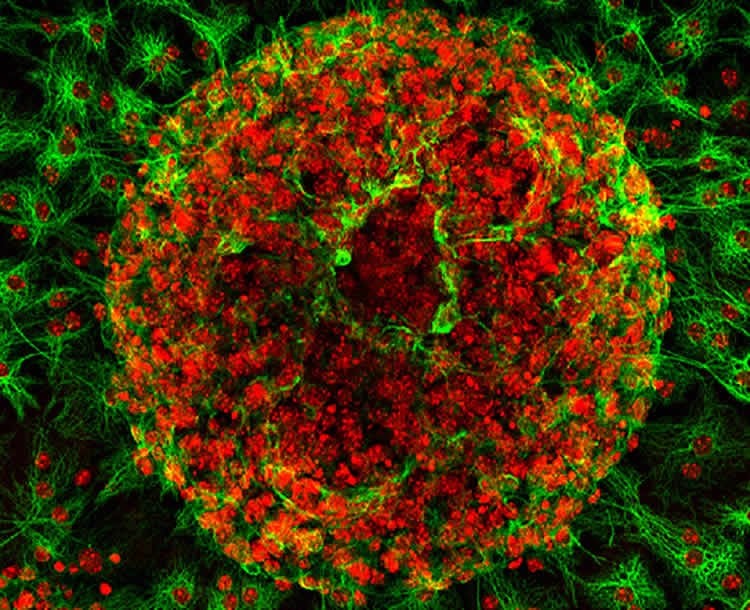Shedding light on possible contributors to autism, schizophrenia and other neuro-psychiatric disorders, researchers have found that a type of support cell abundant in the brain may play a role in the ability of neurons to communicate.
The team of scientists, at Washington University School of Medicine in St. Louis found, in culture, that without these cells — called astrocytes — the ability of neurons to send certain signals is slowed. Such a slowdown could interfere with neuronal development and contribute to conditions linked to communication between neurons, including autism and schizophrenia.
The study is available in The Journal of Neuroscience.
“This work highlights that although neurons are the focus of considerable research, the brain is composed of other types of cells that also are very important,” said first author Courtney Sobieski. “Astrocytes are support cells that appear to play a key role in the development of healthy neurons. The neurons have trouble communicating without the support of astrocytes.”
Senior author Steven Mennerick, PhD, professor of psychiatry, explained that glutamate, a neurotransmitter, plays a key role in carrying messages around the brain.
“It’s the main transmitter at about 90 percent of the points of communication in the brain,” he said. “And we found that when we take away astrocytes, glutamate signaling is compromised.”
Sobieski, a graduate student in Mennerick’s lab, developed a way to grow individual neurons either with or without astrocytes. As they compared the neurons in culture, they found found that when there was no astrocyte, a neuron’s ability to send glutamate signals slowed down and became disjointed.
“The delay was several milliseconds,” explained Mennerick, also an investigator with the Taylor Family Institute for Innovative Psychiatric Research. “That may sound like a small amount of time, but in electrical communication in the central nervous system, a few milliseconds is a very big deal. Such a delay could interfere with neuronal development and contribute to problems seen in conditions such as autism and schizophrenia.”

The disruptions in glutamate signaling linked to astrocytes also may be related to seizure disorders, such as epilepsy, that are characterized by interrupted electrical signaling.
Mennerick said more research is needed but that it is important for researchers to look beyond neurons.
“It may be that the root of a problem is related to a nearby astrocyte,” he said. “So broadening our perspective and keeping those connections in mind when there are disruptions in signaling between neurons is an important implication of this work.”
Funding: Funding for this research comes from the National Institute of Mental Health, the National Institute of General Medical Sciences and the National Institute of Neurological Disorders and Stroke of the National Institutes of Health (NIH), and from the Taylor Family Institute for Innovative Psychiatric Research. NIH grant numbers R21 MH099658, R01 MH101874, T32 GM08151, F31 NS066611 and R01 MH078823.
Source: Jim Dryden – WUSTL
Image Source: The image is credited to NICHD and is licensed CC by 2.0
Original Research: Abstract for “Loss of Local Astrocyte Support Disrupts Action Potential Propagation and Glutamate Release Synchrony from Unmyelinated Hippocampal Axon Terminals In Vitro” by Courtney Sobieski, Xiaoping Jiang, Devon C. Crawford, and Steven Mennerick in Journal of Neuroscience. Published online August 5 2015 doi:10.1523/JNEUROSCI.1289-15.2015
Abstract
Loss of Local Astrocyte Support Disrupts Action Potential Propagation and Glutamate Release Synchrony from Unmyelinated Hippocampal Axon Terminals In Vitro
Neuron–astrocyte interactions are critical for proper CNS development and function. Astrocytes secrete factors that are pivotal for synaptic development and function, neuronal metabolism, and neuronal survival. Our understanding of this relationship, however, remains incomplete due to technical hurdles that have prevented the removal of astrocytes from neuronal circuits without changing other important conditions. Here we overcame this obstacle by growing solitary rat hippocampal neurons on microcultures that were comprised of either an astrocyte bed (+astrocyte) or a collagen bed (−astrocyte) within the same culture dish. −Astrocyte autaptic evoked EPSCs, but not IPSCs, displayed an altered temporal profile, which included increased synaptic delay, increased time to peak, and severe glutamate release asynchrony, distinct from previously described quantal asynchrony. Although we observed minimal alteration of the somatically recorded action potential waveform, action potential propagation was altered. We observed a longer latency between somatic initiation and arrival at distal locations, which likely explains asynchronous EPSC peaks, and we observed broadening of the axonal spike, which likely underlies changes to evoked EPSC onset. No apparent changes in axon structure were observed, suggesting altered axonal excitability. In conclusion, we propose that local astrocyte support has an unappreciated role in maintaining glutamate release synchrony by disturbing axonal signal propagation.
SIGNIFICANCE STATEMENT Certain glial cell types (oligodendrocytes, Schwann cells) facilitate the propagation of neuronal electrical signals, but a role for astrocytes has not been identified despite many other functions of astrocytes in supporting and modulating neuronal signaling. Under identical global conditions, we cultured neurons with or without local astrocyte support. Without local astrocytes, glutamate transmission was desynchronized by an alteration of the waveform and arrival time of axonal action potentials to synaptic terminals. GABA transmission was not disrupted. The disruption did not involve detectable morphological changes to axons of glutamate neurons. Our work identifies a developmental role for astrocytes in the temporal precision of excitatory signals.
“Loss of Local Astrocyte Support Disrupts Action Potential Propagation and Glutamate Release Synchrony from Unmyelinated Hippocampal Axon Terminals In Vitro” by Courtney Sobieski, Xiaoping Jiang, Devon C. Crawford, and Steven Mennerick in Journal of Neuroscience. Published online August 5 2015 doi:10.1523/JNEUROSCI.1289-15.2015






